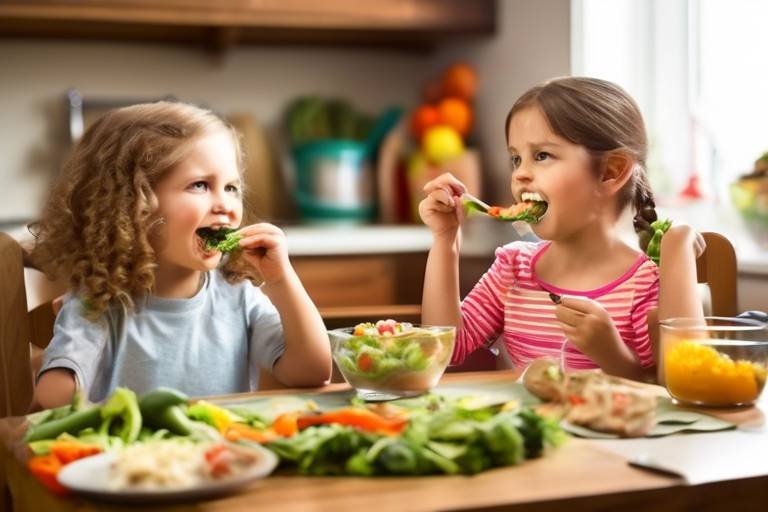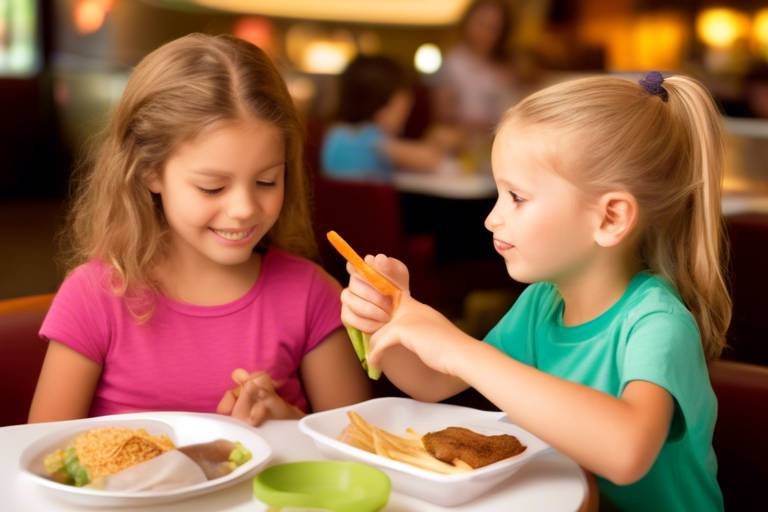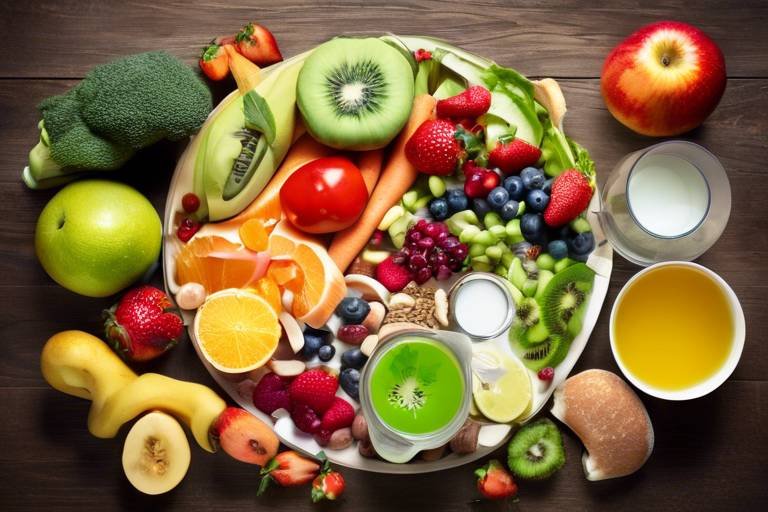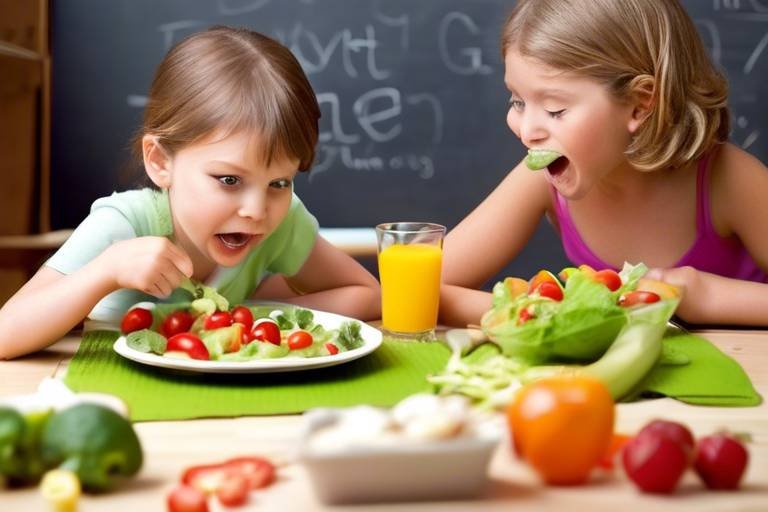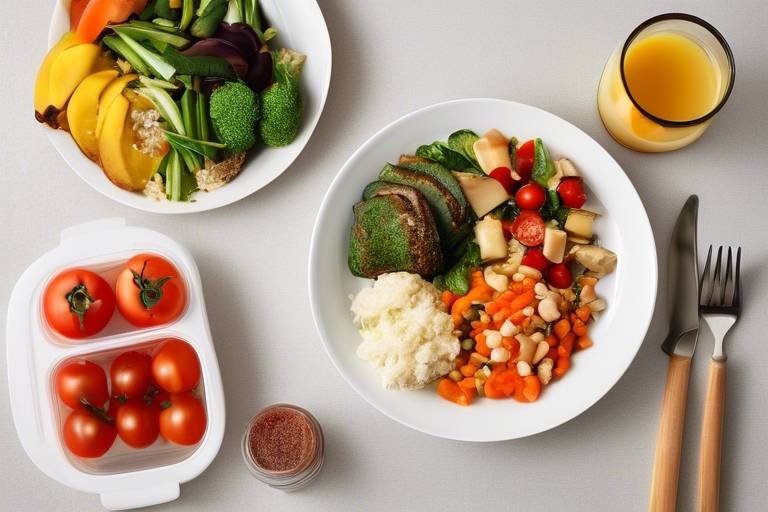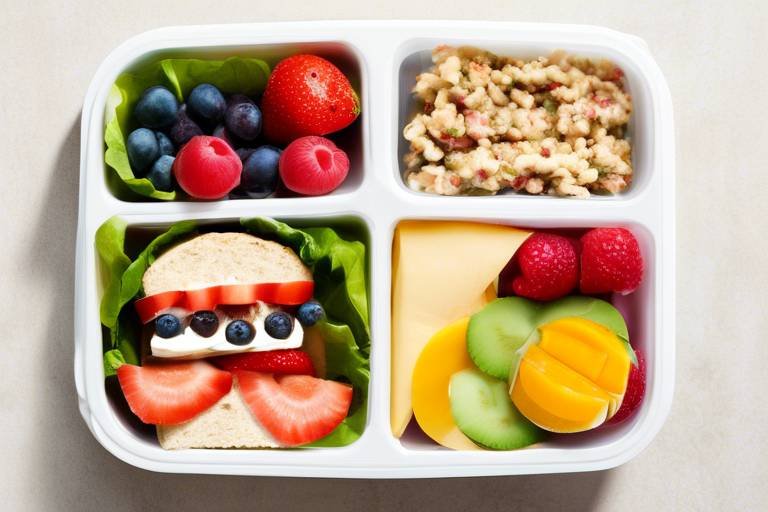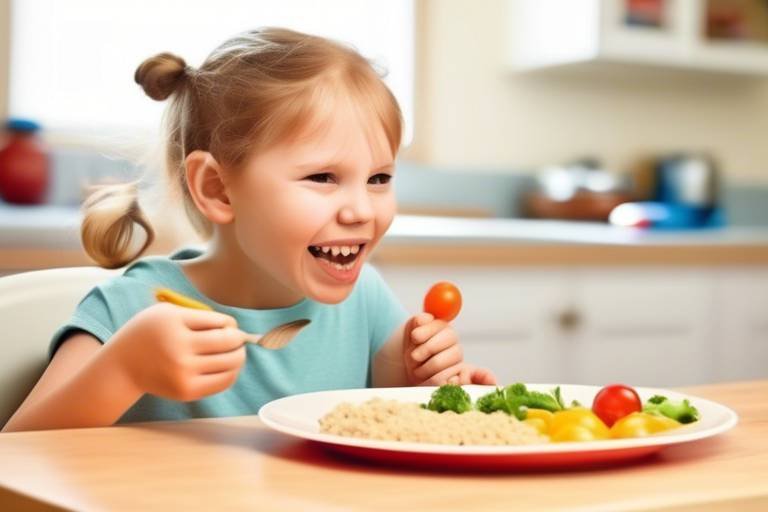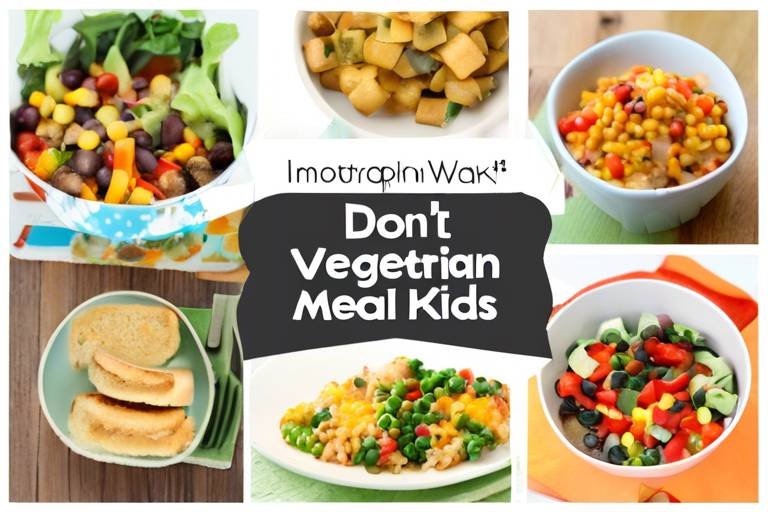A Guide to Kid-Friendly Meal Prep
As parents, we often find ourselves juggling the endless tasks of daily life, and when it comes to meal prep, it can feel like a daunting challenge. But fear not! This article provides you with essential tips and strategies for preparing meals that are not only nutritious but also appealing to children, making family mealtime enjoyable and stress-free. Imagine a scenario where your kids look forward to dinner instead of groaning at the sight of broccoli! By understanding their nutritional needs and involving them in the cooking process, you can create a fun and engaging atmosphere in the kitchen.
Before diving into meal prep, it’s crucial to understand what your little ones need to grow and thrive. Children require a balanced intake of carbohydrates, proteins, fats, vitamins, and minerals to support their rapid growth and high energy levels. For instance, calcium is essential for strong bones, while iron is vital for healthy blood. Incorporating a variety of colorful fruits and vegetables into their meals not only meets these nutritional needs but also makes the plate visually appealing. Think of it like a rainbow on their plate—each color represents different nutrients that contribute to their overall health.
One of the best ways to encourage healthy eating habits is to get your kids involved in the meal prep process. This not only fosters their interest in food but also teaches them valuable kitchen skills that they'll carry into adulthood. Imagine your child proudly saying, “I made this!” when serving dinner to the family. There are countless creative ways to engage children in cooking, from simple tasks like washing vegetables to more complex ones like assembling their own sandwiches. By doing so, you’re not just preparing a meal; you’re creating lasting memories.
To make meal prep exciting, consider incorporating fun cooking activities that can spark your child's curiosity about food. For example, you could host a mini cooking competition where each child creates their own dish using a mystery ingredient. This not only makes cooking fun but also encourages them to try new foods. Another idea is to have a themed dinner night, where everyone helps to prepare dishes from a different culture. This opens up a world of flavors and teaches them about diversity in food.
Setting up a safe and inviting kitchen space is essential for involving children in meal preparation. Ensure that the kitchen is organized and that all tools and ingredients are within their reach. Consider designating a “kids’ corner” with their own utensils, cutting boards, and even a small apron. This not only makes them feel special but also encourages them to take ownership of their cooking tasks. Safety is paramount, so make sure to supervise them closely, especially when using sharp knives or hot appliances.
Assigning age-appropriate tasks is crucial to ensure that children feel accomplished and engaged in the cooking process. Here’s a quick breakdown:
| Age Group | Suggested Tasks |
|---|---|
| 3-5 years | Washing vegetables, stirring ingredients, tearing lettuce |
| 6-8 years | Measuring ingredients, spreading toppings, assembling sandwiches |
| 9-12 years | Chopping soft fruits/vegetables with supervision, following simple recipes |
| 13+ years | Cooking full meals, using kitchen appliances, meal planning |
By tailoring tasks to their age, you’ll not only keep them engaged but also help them build confidence in their cooking abilities.
Now that you’ve got your little chefs involved, it’s time to explore some easy, nutritious recipes that are perfect for kids. Think of dishes that are not only healthy but also packed with flavors that appeal to young palates. For instance, you could whip up colorful veggie wraps using whole-wheat tortillas, fresh veggies, and a tasty hummus spread. Or how about fruit kabobs? Kids love anything on a stick, and this is a fun way to get them to eat more fruits. Remember, the key is to make the food look fun and exciting!
Now that you’re well-versed in involving kids in the kitchen, let’s talk about effective meal prep techniques that can simplify cooking for families. These techniques not only save time but also ensure that healthy meals are always on hand, making weeknight dinners a breeze.
Batch cooking is a game-changer for busy families. By preparing multiple meals at once, you can significantly reduce daily cooking time. Imagine dedicating just a few hours on the weekend to cook large portions of your family’s favorite meals. You can then store them in the fridge or freezer for quick reheating during the week. This strategy not only saves time but also minimizes the stress of daily meal preparation.
Properly freezing and storing meals is essential to maintain freshness and flavor. Invest in good-quality airtight containers and label them with the contents and date. This way, you always know what you have on hand. When reheating, make sure to do it safely to retain the nutrients and taste of your meals. With these techniques, weeknight dinners can become a stress-free experience, allowing you to focus on what really matters—spending quality time with your family.
Q: How can I get my picky eater to try new foods?
A: Involve them in the cooking process and let them choose ingredients. Presenting food in fun shapes or colors can also pique their interest.
Q: What are some quick snacks I can prepare for my kids?
A: Try yogurt parfaits with fruits and granola, or whole-grain crackers with cheese and veggies.
Q: How can I ensure my kids are eating balanced meals?
A: Aim for a variety of food groups on their plates—fruits, vegetables, proteins, and whole grains. Involve them in meal planning to help them understand nutrition.
With these tips and strategies, you're well on your way to creating a kid-friendly meal prep routine that makes cooking fun and enjoyable for the whole family!

Understanding Nutritional Needs
When it comes to our little ones, understanding their nutritional needs is absolutely crucial. Children are in a constant state of growth and development, which means they require a balanced diet rich in essential nutrients. Think of it this way: just like a car needs the right fuel to run smoothly, our kids need the right foods to fuel their bodies and minds. But what exactly do they need?
First off, let’s break down the key nutrients that are vital for children:
- Proteins: These are the building blocks of growth. Found in foods like chicken, beans, and eggs, proteins help in building muscles and repairing tissues.
- Carbohydrates: Often misunderstood, carbs are essential for providing energy. Whole grains, fruits, and vegetables are excellent sources.
- Fats: Healthy fats, such as those found in avocados and nuts, are important for brain development.
- Vitamins and Minerals: These micronutrients play a key role in immune function, bone health, and overall wellness. Foods like leafy greens, fruits, and dairy products are rich in these.
Now, you might be wondering, how can meal prep help in meeting these nutritional needs? Well, preparing meals in advance allows you to plan out a variety of foods that cover all these essential nutrients. It’s like having a roadmap for your child’s nutrition journey!
Moreover, meal prep can significantly reduce the stress of daily cooking. Imagine coming home after a long day, and instead of scrambling to whip up something nutritious, you open the fridge to find a week’s worth of healthy meals ready to go. That’s the magic of meal prep!
Additionally, involving your kids in meal prep can help them understand the importance of nutrition. When they see you selecting fresh ingredients and preparing balanced meals, they’re more likely to develop healthy eating habits themselves. It’s a win-win situation! Plus, it gives you the chance to teach them about different food groups and why each one is important.
In conclusion, understanding your child’s nutritional needs and how to meet them through thoughtful meal prep is essential for their growth and development. By prioritizing a balanced diet filled with proteins, carbohydrates, healthy fats, vitamins, and minerals, you’re setting them up for a healthy future. So, roll up your sleeves, get cooking, and make mealtime a fun and educational experience!

Involving Kids in Meal Prep
Getting kids involved in meal prep can be a game changer for family mealtime! Not only does it make cooking more fun, but it also teaches children valuable skills that they’ll carry with them for life. Imagine your little ones, with their tiny hands, helping you chop veggies or mix ingredients. It’s like having mini sous chefs in your kitchen! Plus, when kids have a hand in preparing their meals, they’re more likely to eat what’s on their plate. After all, who wouldn’t want to try a dish they helped create?
One of the best ways to spark interest in healthy eating is to make the cooking process interactive. You can set up a mini cooking class right in your kitchen. Start by letting your kids pick out a recipe they want to try. This could be something as simple as homemade pizza or colorful fruit skewers. The excitement of choosing what to make gives them a sense of ownership over their meals, making them more eager to eat what they’ve prepared.
Incorporating fun cooking activities can turn meal prep into a delightful adventure. For instance, you can create a “Chopped” style challenge where kids have to use a specific set of ingredients to create a dish. This not only encourages creativity but also helps them think outside the box. You can also introduce them to basic cooking techniques, such as how to sauté vegetables or the importance of measuring ingredients accurately. By doing so, you’re not just teaching them how to cook; you’re also instilling a sense of accomplishment.
Cooking doesn’t have to be a chore; it can be an exciting activity! Here are some fun ideas to make meal prep enjoyable:
- Cooking Competitions: Host a friendly competition where kids can create their own dishes using a selection of ingredients.
- Themed Cooking Nights: Choose a theme for the night, like “Taco Tuesday,” and let the kids help prepare the meal.
- Food Art: Encourage kids to create fun shapes and designs with their food, turning a simple meal into a masterpiece.
Creating a kid-friendly kitchen environment is crucial. Make sure the kitchen is safe and inviting. Set up a designated area where kids can easily access utensils and ingredients. This could be a low shelf with kid-sized tools and colorful bowls. When children feel comfortable in their cooking space, they’re more likely to engage in the process. You can even add a splash of color with fun aprons and chef hats to make them feel like real chefs!
When involving kids in meal prep, it’s essential to assign age-appropriate tasks. This ensures that they feel accomplished without becoming overwhelmed. For younger children, simple tasks such as washing vegetables or stirring ingredients can be perfect. As they grow older, you can introduce more complex tasks like chopping soft fruits or measuring out ingredients. Here’s a quick breakdown of tasks based on age:
| Age Group | Suggested Tasks |
|---|---|
| 3-5 years | Washing veggies, tearing lettuce, mixing ingredients |
| 6-8 years | Measuring ingredients, spreading sauces, assembling sandwiches |
| 9-12 years | Chopping soft fruits, sautéing vegetables, following recipes |
By breaking down tasks in this way, you can ensure that everyone feels involved and valued in the kitchen. It’s all about teamwork and creating a shared experience that the whole family can enjoy. Remember, the goal is to make meal prep a fun and educational experience, so don’t be afraid to get a little messy along the way!

Fun Cooking Activities
Cooking with kids can be an absolute blast! It’s not just about preparing meals; it’s about creating memories, fostering creativity, and building a love for healthy eating. Imagine the joy on your child’s face when they get to wear a little apron and chef's hat, wielding a wooden spoon like a pro! Engaging your little ones in the kitchen can turn mundane meal prep into a delightful adventure. So, let’s dive into some that will make your kitchen the coolest place to be!
One fantastic way to spark interest is through theme nights. For instance, you could have a “Taco Tuesday” where kids can assemble their own tacos with a variety of toppings. This not only makes them feel involved but also encourages them to choose healthy ingredients. You can lay out a colorful array of toppings such as diced tomatoes, shredded lettuce, beans, and cheese, and let them create their own culinary masterpiece. It’s like being a chef in a restaurant, and who wouldn’t love that?
Another exciting activity is to introduce a “Mystery Ingredient Challenge.” You can pick a few ingredients from the pantry and challenge your kids to create a dish using all of them. This not only boosts their creativity but also teaches them about food combinations. Imagine the surprise when they discover that spinach can taste amazing when blended into a smoothie with bananas and yogurt! The possibilities are endless, and the results can be surprisingly delicious.
Don't forget about the joy of baking! Baking is a perfect way to teach kids about measurements, following instructions, and the science of cooking. You could start with simple recipes like cookies or muffins. Let them measure out flour or mix batter; the excitement of seeing their treats rise in the oven is truly magical. Plus, the sweet aroma that fills the house will make everyone feel warm and cozy, turning your kitchen into a haven of happiness.
Lastly, consider hosting a mini cooking competition at home. Divide the family into teams and set a timer. Each team can create a dish with the ingredients available. This not only adds a fun twist but also instills teamwork and communication skills. You can even invite a family member to judge the dishes based on creativity, taste, and presentation. It’s a fantastic way to bond and create lasting memories while enjoying delicious food!
To wrap it up, cooking with kids is all about making it enjoyable and engaging. By incorporating fun activities, you can instill a love for healthy eating and cooking that will last a lifetime. Remember, the kitchen is not just a place for food; it’s a place for fun, laughter, and creativity!
Q: What age is appropriate for kids to start cooking?
A: Kids can start helping in the kitchen as young as 2 or 3 years old, with simple tasks like washing vegetables or stirring ingredients. As they grow, you can introduce them to more complex tasks.
Q: How can I make cooking more appealing to picky eaters?
A: Involve them in the cooking process! Let them choose ingredients or help prepare meals. Making food fun, like creating shapes or colors, can also entice them to try new things.
Q: What are some safe cooking tasks for toddlers?
A: Toddlers can wash fruits and vegetables, tear lettuce for salads, or help sprinkle cheese on dishes. Always supervise them closely to ensure safety.

Creating a Kid-Friendly Kitchen
Creating a kid-friendly kitchen is all about making the space inviting and safe for children. Imagine a vibrant, colorful environment where your little ones feel excited to step in and help out. The first step is to ensure that the kitchen is safe. This means storing sharp knives and heavy pots out of reach, while also securing any hazardous materials. You can use child-proof locks on cabinets to keep curious hands away from cleaning supplies and other dangerous items.
Next, consider the layout of your kitchen. It should be accessible for kids. For instance, keep frequently used items like mixing bowls, measuring cups, and utensils in lower cabinets or drawers that children can easily reach. This not only empowers them to help out but also builds their confidence in the kitchen. You might even designate a specific area or shelf as the "kids' zone," filled with their tools and ingredients, encouraging them to explore and experiment.
Another essential aspect is to involve your children in the design of their cooking space. Let them choose fun colors for aprons or even decorate the walls with their artwork. This creates a personal connection to the kitchen, making them more enthusiastic about cooking. You could even set up a small table where they can sit and enjoy their creations, fostering a sense of pride in their culinary achievements.
Moreover, consider incorporating fun gadgets that make cooking exciting. For example, colorful measuring spoons, fun-shaped cookie cutters, or even a kid-friendly cookbook can spark their interest. These tools not only make cooking more enjoyable but also help them learn measurements and cooking techniques in a fun way.
Lastly, don’t forget to emphasize cleanliness. Teach your kids the importance of washing their hands before and after cooking, and make cleaning up a part of the fun. You can even turn it into a game—who can clean up the fastest? This not only instills good habits but also makes the entire cooking process a shared experience.
In summary, a kid-friendly kitchen is all about safety, accessibility, and fun. By creating a space where children feel welcome and involved, you not only make meal prep easier but also instill a love for cooking that can last a lifetime.
- What age can my child start helping in the kitchen? Most children can start helping with simple tasks as early as 2 or 3 years old, depending on their interest and ability.
- How can I make cooking more fun for my kids? Involve them in the process, let them choose recipes, and use colorful utensils and tools to spark their interest.
- What are some safe tasks for young children? Younger kids can help wash vegetables, stir ingredients, or set the table, while older kids can assist with chopping and measuring.

Choosing Age-Appropriate Tasks
When it comes to involving kids in the kitchen, one of the most important factors to consider is ensuring that the tasks are age-appropriate. This not only keeps them safe but also allows them to feel a sense of accomplishment. Think of it like teaching a child to ride a bike; you wouldn’t start them off on a steep hill, right? You’d begin on flat ground, gradually introducing more challenges as they gain confidence. Similarly, in the kitchen, the tasks should match their developmental stage.
For toddlers, simple tasks like washing vegetables or stirring ingredients can be a great start. They’re still learning about their environment, and these activities can help them develop fine motor skills. As they grow into preschoolers, they can take on slightly more complex tasks, such as measuring ingredients or spreading peanut butter on bread. This is the perfect time to introduce them to the concept of recipes and following instructions, which is not only fun but also educational.
As children reach elementary school age, they can handle more responsibility in the kitchen. This includes tasks like chopping soft vegetables with a child-safe knife, mixing batters, or even helping to set the table. At this stage, you can start teaching them about kitchen safety, such as the importance of washing hands before cooking and being cautious around hot surfaces. Engaging them in discussions about healthy eating can also spark their interest in trying new foods.
Here’s a quick reference table to help you identify tasks suitable for different age groups:
| Age Group | Suggested Tasks |
|---|---|
| Toddlers (2-3 years) | Washing vegetables, stirring, and pouring ingredients. |
| Preschoolers (4-5 years) | Measuring ingredients, spreading, and simple mixing. |
| Early Elementary (6-8 years) | Chopping soft vegetables, following simple recipes, and setting the table. |
| Older Elementary (9-12 years) | Using a stove with supervision, baking, and meal planning. |
As children approach their teenage years, they can take on full meal prep responsibilities. This is an excellent opportunity to teach them about nutrition, budgeting, and even planning meals for the week. By this age, they should be comfortable with most kitchen tasks and can even experiment with their own recipes. Encouraging independence in the kitchen not only builds their confidence but also sets them up for success in adulthood.
In conclusion, choosing age-appropriate tasks is crucial for making meal prep a fun and educational experience for kids. By starting with simple tasks and gradually increasing the complexity, you’ll not only keep them engaged but also teach them valuable skills that will last a lifetime. Remember, the kitchen is a fantastic place for children to learn, grow, and bond with family, so make the most of it!
Q: What age should I start involving my child in meal prep?
A: You can start involving toddlers in simple tasks like washing vegetables. As they grow, gradually introduce more complex tasks.
Q: How can I make cooking more fun for my kids?
A: Incorporate games, let them choose recipes, and use colorful ingredients to make the process visually appealing.
Q: What are some safety tips for cooking with children?
A: Always supervise them, teach them about kitchen safety, and use child-friendly tools to minimize risks.

Healthy Recipe Ideas
When it comes to cooking for kids, the key is to strike a balance between nutritious and delicious. You want meals that not only fuel their growing bodies but also tantalize their taste buds. Here are some healthy recipe ideas that are not only easy to prepare but also fun for kids to eat!
One of the simplest and most versatile recipes is the classic Veggie-Packed Quesadilla. Start by taking whole wheat tortillas and filling them with a mix of shredded cheese, black beans, and colorful vegetables like bell peppers, spinach, and corn. Kids can help by choosing their favorite veggies and layering them in the tortilla. Once assembled, pop them on a skillet until golden brown and crispy. Serve with a side of homemade guacamole for a nutritious dip that they’ll love!
Another fantastic option is Fruit and Yogurt Parfaits. This dish is not only visually appealing but also allows kids to get creative. Layer Greek yogurt with a variety of fruits such as strawberries, blueberries, and bananas. Add a sprinkle of granola for some crunch. You can even let your kids choose their favorite fruits and build their own parfait. It’s a fun way to get them excited about healthy eating!
If you’re looking for a hearty meal, try making Whole Wheat Pasta Salad. Cook up some whole wheat pasta and toss it with cherry tomatoes, cucumbers, olives, and a drizzle of olive oil and lemon juice. You can also add in some protein like grilled chicken or chickpeas for an extra nutritional boost. This dish is great for meal prep, as it can be made in advance and stored in the fridge, making it a quick grab-and-go option for busy days.
For a warm and comforting dish, consider Mini Turkey Meatballs. Mix ground turkey with breadcrumbs, grated carrots, and spices, then roll them into small balls. Bake them in the oven for a healthier alternative to frying. Serve with a side of whole grain spaghetti and marinara sauce. Kids will love the bite-sized meatballs, and you can sneak in some extra veggies by adding finely chopped spinach or zucchini to the mix!
Lastly, don’t forget about DIY Pizza Night. Set up a pizza-making station with whole wheat pita bread or pre-made pizza crusts, a variety of toppings, and sauces. Let the kids create their own personal pizzas with their favorite toppings, from marinara sauce to a rainbow of veggies and lean meats. This not only makes for a fun family activity but also encourages kids to try different ingredients.
Incorporating these healthy recipes into your meal prep routine can make mealtime exciting and enjoyable for your little ones. Remember, the more involved they are in the cooking process, the more likely they are to eat what’s on their plate. So, roll up your sleeves, get creative, and enjoy the process of cooking together!
Q: How can I encourage my kids to try new foods?
A: Involve them in the cooking process! When kids help prepare meals, they are more likely to be curious about trying new ingredients. Also, make new foods visually appealing and fun to eat.
Q: What are some quick snacks I can prepare for my kids?
A: Consider options like apple slices with peanut butter, yogurt with fresh fruit, or whole grain crackers with cheese. These snacks are nutritious and easy to prepare!
Q: How can I make healthy meals more appealing to kids?
A: Use fun shapes, vibrant colors, and interactive elements like build-your-own meals (like tacos or pizzas). Kids are more likely to enjoy meals that look fun and engaging!

Meal Prep Techniques
When it comes to feeding a family, can be a game changer. Imagine walking into your kitchen on a busy weeknight and knowing exactly what’s for dinner. No more frantic searches through the fridge or last-minute takeout orders! By implementing effective meal prep strategies, you can save time, reduce stress, and ensure your family enjoys healthy, home-cooked meals every day of the week.
One of the most popular techniques is batch cooking. This method involves preparing large quantities of food at once, which can then be portioned out for multiple meals. Think of it as cooking once and eating twice (or thrice!). Not only does this save you precious time during the week, but it also allows you to take advantage of bulk buying, which can be more cost-effective.
For example, you might spend a Sunday afternoon cooking a big pot of chili, roasting a tray of vegetables, and grilling some chicken. Once everything has cooled, you can divide them into individual containers and stash them in the fridge or freezer. This way, when the dinner hour rolls around, all you have to do is heat up a pre-prepared meal. Easy peasy!
Another important aspect of meal prep is freezing and storing meals properly. Proper storage techniques not only help maintain the freshness and flavor of your meals, but they also prevent food waste. Here are a few tips:
- Use airtight containers or freezer bags to prevent freezer burn.
- Label each container with the date and contents for easy identification.
- Consider portion sizes when freezing—smaller portions are easier to defrost and consume.
Additionally, some foods freeze better than others. For instance, soups, stews, and casseroles tend to hold up well, while salads and raw vegetables might not fare as well after thawing. By being mindful of what you freeze, you can ensure your meals retain their deliciousness.
Meal prep isn’t just about cooking; it’s also about planning. Take some time at the beginning of each week to map out your meals. This could be as simple as jotting down a few ideas on a notepad or using a digital meal planning app. Having a plan in place means you can shop for ingredients accordingly, reducing the number of trips to the grocery store and minimizing impulse buys.
In summary, embracing can transform your family’s dining experience. From batch cooking to effective freezing and thoughtful planning, these strategies can help you create a stress-free kitchen environment where delicious meals are always at your fingertips. So, roll up those sleeves and get started—you’ll be amazed at how much easier family mealtime can be!
Q: How long can I keep meals in the freezer?
A: Most cooked meals can be safely frozen for up to 3 months. However, for the best flavor and texture, try to consume them within 1-2 months.
Q: Can I freeze raw ingredients?
A: Yes, many raw ingredients can be frozen, but make sure to wash and prep them first. For example, chopped vegetables and meats can be frozen for later use.
Q: What are some kid-friendly meals I can batch cook?
A: Some great options include chili, pasta dishes, casseroles, and soups. These meals are not only nutritious but also appeal to young taste buds!

Batch Cooking
Batch cooking is a game-changer for busy families looking to simplify their meal preparation while ensuring that nutritious options are always available. Imagine coming home after a long day, exhausted and hungry, only to find a fridge full of ready-made meals waiting for you. Sounds like a dream, right? Well, with batch cooking, that dream can become a reality! By dedicating a few hours on the weekend or during your free time to prepare meals in advance, you can save yourself the daily stress of cooking and still provide your family with healthy, delicious food.
So, how does batch cooking work? It’s all about cooking large quantities of food at once and then storing them for later use. This method not only cuts down on cooking time during the week but also encourages you to plan your meals ahead of time, which can lead to healthier choices. You can prepare a variety of dishes, from stews and casseroles to grilled chicken and roasted vegetables, all in one go. The key is to choose recipes that store well and can be easily reheated without losing flavor or texture.
Here’s a simple breakdown of how to get started with batch cooking:
- Plan Your Menu: Choose a few recipes that your family loves and that can be made in large quantities. Think about meals that freeze well, such as soups, chili, or pasta dishes.
- Shop Smart: Make a grocery list based on your menu and stick to it. Buying in bulk can also save you money and ensure you have everything you need.
- Cook Efficiently: Use your time wisely by multitasking. For example, while one pot is simmering, you can chop vegetables or bake something in the oven.
- Store Properly: Invest in good-quality containers that are freezer-safe and stackable. Label each container with the name of the dish and the date it was prepared to keep things organized.
Batch cooking not only saves time but also helps reduce food waste. When you prepare meals in advance, you can use up ingredients that might otherwise spoil. Plus, it encourages you to get creative with leftovers. For instance, if you make a large pot of roasted vegetables, you can use them in salads, stir-fries, or as a side dish throughout the week. It’s all about maximizing your efforts!
To give you an idea of how effective batch cooking can be, here’s a simple table comparing the time spent cooking daily versus batch cooking:
| Cooking Method | Time Spent Per Week | Advantages |
|---|---|---|
| Daily Cooking | 10-15 hours | Fresh meals every day |
| Batch Cooking | 2-4 hours | Less stress, more variety, reduced waste |
In conclusion, batch cooking is a fantastic strategy for families who want to eat healthy without spending hours in the kitchen every day. By preparing meals in advance, you can enjoy the benefits of home-cooked food while freeing up your evenings for family time, relaxation, or even a little self-care. So why not give it a try? You might just find that it transforms your family's mealtime experience!

Freezing and Storing Meals
Freezing and storing meals is a game-changer for busy families. Imagine coming home after a long day, and instead of scrambling to make dinner, you simply pull a delicious, homemade meal out of the freezer. It’s like having a personal chef on standby! But to make the most of your frozen meals, there are some essential tips and tricks to keep in mind.
First off, proper packaging is crucial. You want to ensure that your meals are protected from freezer burn, which can ruin the taste and texture. Use airtight containers or heavy-duty freezer bags to seal in freshness. When using bags, try to remove as much air as possible before sealing. This not only prevents freezer burn but also saves space in your freezer!
Another important aspect to consider is labeling. It’s easy to forget what’s in your freezer, especially when you're juggling multiple meals. Create a simple labeling system that includes the name of the dish and the date it was prepared. You can even add cooking instructions if you want to make reheating a breeze. For example:
| Meal | Date Prepared | Reheating Instructions |
|---|---|---|
| Vegetable Stir-Fry | 10/15/2023 | Microwave for 5 minutes or sauté on the stove for 7 minutes. |
| Chicken Alfredo | 10/16/2023 | Thaw overnight in the fridge, then heat in a saucepan for 10 minutes. |
When it comes to storing meals, be mindful of how long they can stay in the freezer. Generally, most cooked meals can last up to three months. However, for the best taste and texture, aim to eat them within the first month. This way, you can enjoy your meals at their peak flavor!
Lastly, don’t forget about thawing methods! The safest way to thaw frozen meals is in the refrigerator overnight. This ensures that the meal stays at a safe temperature and reduces the risk of bacteria growth. If you’re in a hurry, you can also use the microwave's defrost setting, but be cautious not to start cooking the meal in the process.
By mastering the art of freezing and storing meals, you can create a stress-free dinner routine that keeps your family happy and healthy. With a little planning and organization, you’ll find that mealtime can be both enjoyable and efficient!
- How long can I keep meals in the freezer? Most cooked meals can last up to three months, but for best quality, consume them within one month.
- Can I freeze meals in glass containers? Yes, but make sure they are labeled as freezer-safe to prevent breaking.
- What’s the best way to reheat frozen meals? The safest method is to thaw in the refrigerator overnight and then reheat on the stove or microwave.
Frequently Asked Questions
- What are some essential nutrients my child needs?
Children require a balanced diet rich in protein, carbohydrates, healthy fats, vitamins, and minerals to support their growth and development. Key nutrients include calcium for strong bones, iron for energy, and vitamin C for a healthy immune system. Focusing on a variety of fruits, vegetables, whole grains, and lean proteins can help meet these nutritional needs.
- How can I get my kids involved in meal prep?
Involving kids in meal prep can be a fun and educational experience! Start by assigning them simple tasks like washing vegetables, stirring ingredients, or setting the table. You can also create a fun cooking activity like making homemade pizzas where they can choose their own toppings. This not only teaches them valuable kitchen skills but also encourages them to try new foods.
- What are some easy and healthy recipes for kids?
There are plenty of easy and nutritious recipes that kids will love! Consider making fruit smoothies with yogurt and their favorite fruits, or whole grain pancakes that they can help mix and flip. Another fun option is vegetable stir-fry, where they can pick and add their favorite veggies. The key is to keep it colorful and flavorful!
- What is batch cooking, and how can it help my family?
Batch cooking involves preparing large quantities of food at once, which can save you time during the week. By cooking meals in bulk, you can have healthy options ready to go, making weeknight dinners a breeze. Just cook, portion, and store in the fridge or freezer for easy access. It’s a great way to ensure your family always has nutritious meals available!
- How do I properly freeze and store meals?
To freeze and store meals effectively, make sure to use airtight containers or freezer bags to prevent freezer burn. Label each container with the date and contents for easy identification. Most cooked meals can be frozen for up to 3 months. When reheating, ensure the food is heated thoroughly to maintain its flavor and safety.





